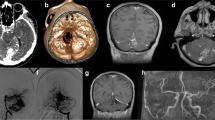Abstract
Purpose
The aim of the study is to evaluate the efficiency of turbo spin-echo (TSE), three-dimensional constructive interference in the steady state (3D CISS) and cine phase contrast (Cine PC) sequences in determining flow through the endoscopic third ventriculostomy (ETV) fenestration, and to determine the effect of various TSE sequence parameters.
Materials and methods
The study was approved by our institutional review board and informed consent from all patients was obtained. Two groups of patients were included: group I (24 patients with good clinical outcome after ETV) and group II (22 patients with hydrocephalus evaluated preoperatively). The imaging protocol for both groups was identical. TSE T2 with various sequence parameters and imaging planes, and 3D CISS, followed by cine PC were obtained. Flow void was graded as four-point scales. The sensitivity, specificity, accuracy, positive and negative predictive values of sequences were calculated.
Results
Bidirectional flow through the fenestration was detected in all group I patients by cine PC. Stroke volumes through the fenestration in group I ranged 10–160.8 ml/min. There was no correlation between the presence of reversed flow and flow void grading. Also, there was no correlation between the stroke volumes and flow void grading. The sensitivity of 3D CISS was low, and 2 mm sagittal TSE T2, nearly equal to cine PC, provided best result.
Conclusion
Cine PC and TSE T2 both have high confidence in the assessment of the flow through the fenestration. But, sequence parameters significantly affect the efficiency of TSE T2.


Similar content being viewed by others
References
Fischbein NJ, Ciricillo SF, Barr RM, McDermott M, Edwards MS, Geary S, Barkovich AJ (1998) Endoscopic third ventriculocisternostomy: MR assessment of patency with 2-D cine phase-contrast versus T2-weighted fast spin echo technique. Pediatr Neurosurg 28:70–78
Joseph VB, Raghuram L, Korah IP, Chacko AG (2003) MR ventriculography for the study of CSF flow. AJNR 24:373–381
Kim SK, Wang KC, Cho BK (2000) Surgical outcome of pediatric hydrocephalus treated by endoscopic III ventriculostomy: prognostic factors and interpretation of postoperative neuroimaging. Childs Nerv Syst 16:161–168
Bargallo N, Olondo L, Garcia AI, Capurro S, Caral L, Rumia J (2005) Functional analysis of third ventriculostomy patency by quantification of CSF stroke volume by using cine phase-contrast MR imaging. AJNR 26:2514–2521
Feng H, Huang G, Liao X, Fu K, Tan H, Pu H, Cheng Y, Liu W, Zhao D (2004) Endoscopic third ventriculostomy in the management of obstructive hydrocephalus: an outcome analysis. J Neurosurg 100:626–633
Fukuhara T, Luciano MG, Kowalski RJ (2002) Clinical features of third ventriculostomy failures classified by fenestration patency. Surg Neurol 58:102–110
Fukuhara T, Vorster SJ, Ruggieri P, Luciano MG (1999) Third ventriculostomy patency: comparison of findings at cine phase-contrast MR imaging and at direct exploration. AJNR 20:1560–1566
Hopf NJ, Grunert P, Fries G, Resch KD, Perneczky A (1999) Endoscopic third ventriculostomy: outcome analysis of 100 consecutive procedures. Neurosurgery 44:795–804
Jack CR Jr, Kelly PJ (1989) Stereotactic third ventriculostomy: assessment of patency with MR imaging. AJNR 10:515–522
Lev S, Bhadelia RA, Estin D, Heilman CB, Wolpert SM (1997) Functional analysis of third ventriculostomy patency with phase-contrast MRI velocity measurements. Neuroradiology 39:175–179
Mohanty A, Vasudev MK, Sampath S, Radhesh S, Sastry Kolluri VR (2002) Failed endoscopic third ventriculostomy in children: management options. Pediatr Neurosurg 37:304–309
Wilcock DJ, Jaspan T, Worthington BS, Punt J (1997) Neuro-endoscopic third ventriculostomy: evaluation with magnetic resonance imaging. Clin Radiol 52:50–54
Aleman J, Jokura H, Higano S, Akabane A, Shirane R, Yoshimoto T (2001) Value of constructive interference in steady-state three-dimensional, Fourier transformation magnetic resonance imaging for the neuroendoscopic treatment of hydrocephalus and intracranial cysts. Neurosurgery 48:1291–1295, discussion 1295–1296
Connor SE, O’Gorman R, Summers P, Simmons A, Moore EM, Chandler C, Jarosz JM (2001) SPAMM, cine phase contrast imaging and fast spin-echo T2-weighted imaging in the study of intracranial cerebrospinal fluid (CSF) flow. Clin Radiol 56:763–772
Doll A, Christmann D, Kehrli P, Abu Eid M, Gillis C, Bogorin A, Thiebaut A, Dietemann JL (2000) Contribution of 3D CISS MRI for pre- and post-therapeutic monitoring of obstructive hydrocephalus. J Neuroradiol 27:218–225
Hoffmann KT, Lehmann TN, Baumann C, Felix R (2003) CSF flow imaging in the management of third ventriculostomy with a reversed fast imaging with steady-state precession sequence. Eur Radiol 13:1432–1437
Malko JA, Hoffman JC Jr, McClees EC, Davis PC, Braun IF (1998) A phantom study of intracranial CSF signal loss due to pulsatile motion. AJNR 9:83–89
Dincer A, Kohan S, Ozek MM (2009) Is all “communicating” hydrocephalus really communicating? Prospective study on the value of 3D-constructive interference in steady state sequence at 3 T. AJNR 30(10):1898–1906
Low RN, Hinks RS, Alzate GD, Shimakawa A (1994) Fast spin-echo MR imaging of the abdomen: contrast optimization and artifact reduction. J Magn Reson Imaging 4:637–645
Hennig J, Friedburg H (1988) Clinical applications and methodological developments of the RARE technique. Magn Reson Imaging 6:391–395
Jolesz FA, Jones KM (1993) Fast spin-echo imaging of the brain. Top Magn Reson Imaging 5:1–13
Mulkern RV, Wong ST, Winalski C, Jolesz FA (1990) Contrast manipulation and artifact assessment of 2D and 3D RARE sequences. Magn Reson Imaging 8:557–566
Stark DD, Hendrick RE, Hahn PF, Ferrucci JT Jr (1987) Motion artifact reduction with fast spin-echo imaging. Radiology 164:183–191
Jones KM, Mulkern RV, Schwartz RB, Oshio K, Barnes PD, Jolesz FA (1992) Fast spin-echo MR imaging of the brain and spine: current concepts. AJR 158:1313–1320
Li T, Mirowitz SA (2003) Fast T2-weighted MR imaging: impact of variation in pulse sequence parameters on image quality and artifacts. Magn Reson Imaging 21:745–753
Conflict of interest
The authors declare that they have no conflict of interest.
Disclosure
The authors have no disclosure.
Author information
Authors and Affiliations
Corresponding author
Rights and permissions
About this article
Cite this article
Dinçer, A., Yildiz, E., Kohan, S. et al. Analysis of endoscopic third ventriculostomy patency by MRI: value of different pulse sequences, the sequence parameters, and the imaging planes for investigation of flow void. Childs Nerv Syst 27, 127–135 (2011). https://doi.org/10.1007/s00381-010-1219-6
Received:
Accepted:
Published:
Issue Date:
DOI: https://doi.org/10.1007/s00381-010-1219-6




